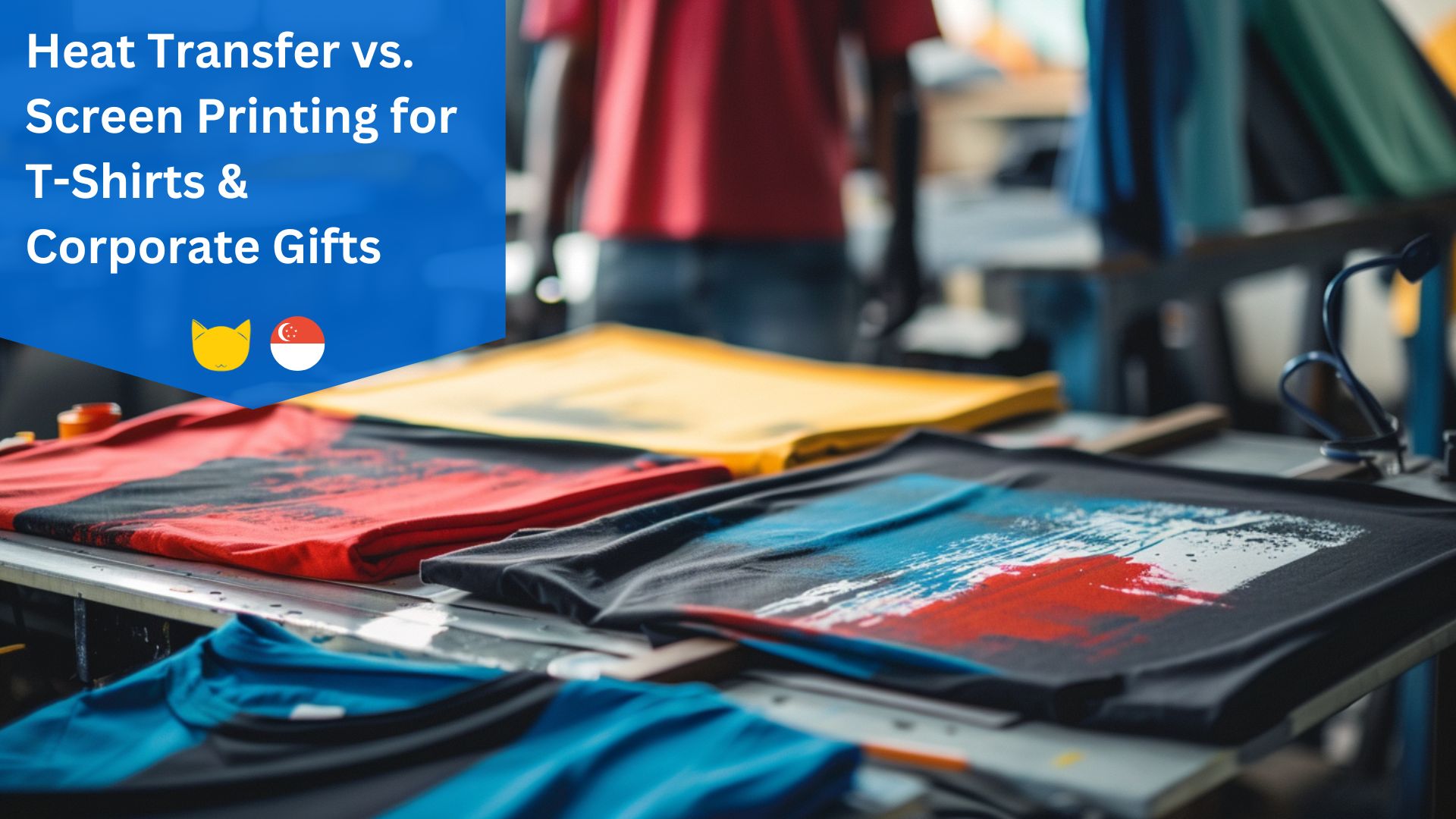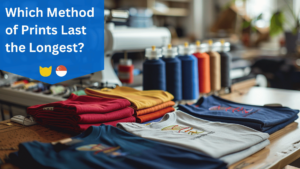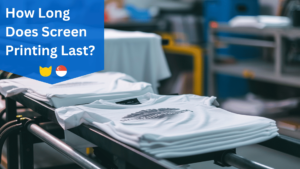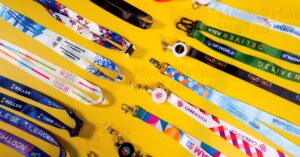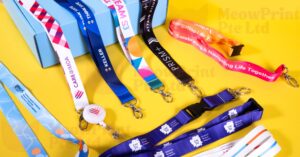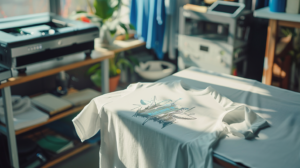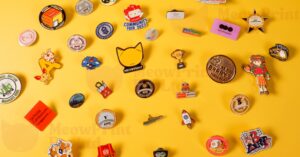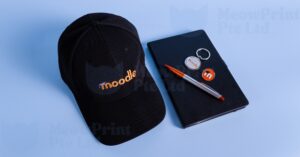Heat Transfer vs. Screen Printing
If you are deciding to choose between heat transfer and silk screen printing, you will first need to consider your order size and design complexity.
Heat transfer works best for small runs (under 25 pieces) and intricate designs with unlimited colors, lasting through about 50 washes.
Screen printing becomes cost-effective for orders over 25 pieces, offering superior durability (5-10 years) and vibrant results, especially on dark fabrics.
You’ll pay more upfront for screen printing ($200-500 setup) versus heat transfer ($50-100 setup), but screen printing’s per-unit costs decrease considerably with volume.
Your choice will depend on factors like quantity, design detail, and material type – each method offering distinct advantages for specific project needs.
Are You Looking For Customization?
If you need T-Shirts & Apparels or Corporate Gifts with MOQ 20 pieces, let us help you!
Key Takeaways
- Heat transfer is ideal for small orders and complex designs, while screen printing becomes cost-effective for orders exceeding 25 pieces.
- Heat transfer prints last through 50 washes, while screen printing maintains vibrancy for 5-10 years under normal conditions.
- Screen printing delivers vibrant colors on dark fabrics with raised texture; heat transfer offers smooth, detailed imagery with unlimited color options.
- Setup costs are lower for heat transfer ($50-100) compared to screen printing ($200-500), making it better for varied corporate designs.
- Heat transfer works better on synthetic and stretchy materials, while screen printing performs exceptionally well on cotton fabrics.
Production Methods Explained

When choosing between heat transfer and screen printing for custom t-shirts, it’s important to understand how each method works. These production techniques differ considerably in their approach and print quality.
Heat transfer involves either cutting designs from vinyl or digitally printing onto special paper, then applying heat and pressure to bond the image to the fabric. You’ll find this method particularly effective for complex, multi-colored designs and small orders.
This relatively recent innovation has gained significant popularity in the promotional products industry over the past two decades. With over 4,700 discussions about material options in online forums, crafters actively share their experiences with different transfer materials.
Screen printing, on the other hand, requires creating separate mesh screens for each color in your design. The ink is pressed through these screens onto the garment, penetrating deeply into the fabric.
While this process takes longer to set up, it’s ideal for larger orders and creates durable prints that withstand repeated washing.
If you are looking for custom corporate gifts singapore, we also offer a wide range of over 1,000 unique gifts for you to customise! They also use the above techniques, hence applicable in terms how long the prints will last on these corporate gifts as well.
Cost Analysis and Order Sizes
When you’re choosing between screen printing and heat transfer, the order size considerably impacts your costs.
You’ll find screen printing has higher setup costs but becomes more economical for large orders of 25+ pieces, while heat transfer is cost-effective for smaller runs due to minimal setup fees.
Your long-term costs will vary based on order frequency and volume, with screen printing offering better value for consistent bulk orders despite its higher initial investment. The detailed process of creating individual screens and stencils for each color makes initial setup time particularly significant.
For optimal heat transfer results, maintaining precise temperatures between 340°F to 365°F is essential for quality adhesion.
Cost For Different Volumes
As businesses weigh their options between heat transfer and screen printing, understanding cost variations across different order volumes becomes essential.
When implementing pricing strategies for custom apparel, you’ll find that heat transfer proves more economical for orders under 100 pieces, while screen printing offers better bulk discounts for larger quantities.
The specialized equipment investment required for screen printing contributes to its higher initial costs. With increasing order sizes, the screen printing method becomes more appealing as a cost distribution solution for promotional products.
For small runs under 25 pieces, you’ll benefit from heat transfer’s minimal setup costs and flexibility with complex designs. However, if you’re planning orders exceeding 100 pieces with the same design, screen printing becomes your most cost-effective choice.
Here’s why:
- Heat transfer: Lower initial costs, ideal for varied designs
- Screen printing: Higher setup costs, but decreased per-unit pricing
- Break-even point: Usually around 25-50 pieces
- Best cost efficiency: Screen printing for 500+ identical items
Setup Costs and Pricing
Understanding setup costs between heat transfer and screen printing can make or break your budget decisions. Each printing process requires screen preparation when creating complex designs with multiple colors.
When comparing these methods, you’ll find significant differences in initial investment and operational requirements. Screen printing achieves cost-effective production once your order reaches several hundred units.
| Cost Factor | Heat Transfer | Screen Printing |
|---|---|---|
| Initial Setup | $50-100 | $200-500 |
| Equipment Needed | Heat Press Only | Press, Screens, Racks |
| Space Required | Small Area | Large Workshop |
| Color Cost Impact | No Extra Cost | +$20-30 per Color |
In your setup cost comparison, consider that heat transfer requires minimal upfront investment and works well for small orders or diverse designs.
Are You Looking For Customization?
If you need T-Shirts & Apparels or Corporate Gifts with MOQ 20 pieces, let us help you!
Screen printing’s pricing strategies typically favor larger quantities, as the higher setup costs are offset by faster production and lower per-unit costs.
You’ll need more space and equipment for screen printing, while heat transfer can operate effectively in compact areas.
Durability and Maintenance
Since durability plays an essential role in choosing between decoration methods, you’ll find notable differences between heat transfers and screen printing.
While heat transfer durability typically extends through 50 washes when properly applied, screen printing can maintain its vibrancy for 5-10 years under normal wear conditions.
Testing transfer samples before starting large projects helps ensure optimal application and longevity. Regular exposure to direct sunlight can significantly reduce the lifespan of both printing methods.
To maximize the lifespan of your decorated garments:
- Wash all items inside out using cold water and mild detergent
- Dry on low heat or lay flat to prevent damage
- Avoid ironing directly over printed designs
- Never use bleach or harsh cleaning agents
Screen printing maintenance is generally more forgiving due to its deep ink penetration into the fabric.
Heat transfers require more careful handling since they’re prone to cracking and fading, especially with improper application or aggressive washing cycles.
Design and Color Options
When you’re deciding between heat transfer and screen printing for your t-shirt designs, understanding their color capabilities is essential.
Heat transfer printing excels at reproducing complex designs with unlimited color options, including gradients and photographic elements, while screen printing requires separate screens for each color and works best with simpler designs using fewer colors.
You’ll find that heat transfer offers more design flexibility for small runs and intricate artwork, though screen printing remains the go-to choice for bold, solid-color designs produced in large quantities.
For businesses planning large production runs, screen printing’s reusable stencils make it a more cost-efficient choice over time. Our logo submission requirements in EPS or AI format ensure the highest quality reproduction regardless of which printing method you choose.
Color Range Differences
The color range capabilities of heat transfer and screen printing create distinct advantages for different design scenarios.
Heat transfer methods, particularly those using CMYK profiles, excel at reproducing complex color theory elements and modern design trends, while screen printing offers precise Pantone matching for brand consistency.
Converting from RGB to CMYK ensures proper color reproduction in heat transfer designs. Screen printing’s versatility allows for custom ink mixing to achieve any Pantone color needed.
- Heat transfer supports full-color photographs and gradients through CMYK processing
- Screen printing typically handles up to 4 colors efficiently, perfect for bold logos
- Heat transfer provides smoother color shifts and detailed imagery
- Screen printing delivers exact Pantone matches with specialty options like metallics
When choosing between methods, consider your design’s color complexity. Heat transfer accommodates intricate, multi-colored designs, while screen printing excels at delivering consistent, bold spot colors with distinctive texture.
Design Complexity Comparison
Both heat transfer and screen printing offer distinct design complexity capabilities that’ll impact your choice between the two methods.
Screen printing presents notable design limitations, being best suited for simple, bold designs with minimal colors. Each color requires a separate screen, making complex designs more challenging to produce.
Heat transfer methods provide superior print quality for intricate designs. You’ll get excellent results with:
- Detailed photographic prints
- Complex gradients
- Fine line work
- Multiple color variations
While screen printing creates a bold, textured appearance on fabric, heat transfer printing creates a layer of design being pressed onto the fabric. This might create a heavy feel to the apparel if the design is big.
DTF printing offers a middle ground, providing detailed designs with a slightly noticeable texture. Consider your design’s complexity when choosing – screen printing for bold simplicity, heat transfer for intricate detail.
Material Compatibility

Selecting appropriate fabrics plays an essential role in determining whether you’ll achieve better results with heat transfer or screen printing.
Are You Looking For Customization?
If you need T-Shirts & Apparels or Corporate Gifts with MOQ 20 pieces, let us help you!
Multi-colored designs can be achieved through separate screens in screen printing, making it ideal for complex logo patterns. While heat transfer offers versatility across various fabric blends with consistent adhesion properties, screen printing typically performs best on cotton-rich materials.
The choice between these methods often depends on your specific material needs and durability requirements. Water-based ink produces exceptionally soft prints that maintain garment comfort.
Key material considerations to review before choosing your printing method:
- Cotton fabrics work excellently with both methods but provide superior durability with screen printing
- Synthetic materials like polyester respond well to heat transfer but may require special inks for screen printing
- Stretchy fabrics generally yield better results with heat transfer due to its flexibility
- Dark fabrics perform similarly with both methods, though screen printing offers better color vibrancy
Aesthetic Impact
When deciding between heat transfer and screen printing, you’ll discover that each method creates distinctly different visual results. The aesthetic appeal varies greatly between these techniques, with each offering unique advantages for specific design needs.
Heat transfer excels at producing complex, multi-colored designs with high resolution and intricate details. You’ll get crisp, smooth images that are particularly vibrant on light-colored fabrics.
However, the visual impact may diminish over time as these designs can fade or crack. The process is versatile enough for use on multiple surface types, including ceramics and metals.
Screen printing, while limited in color complexity, delivers superior results for bold, simple designs. You’ll notice:
- More vibrant colors on dark fabrics
- A slightly raised texture that becomes part of the material
- Better long-term durability
- Sharper edges and finer details in color representation
- A more natural look and feel
Environmental Concerns
Understanding the environmental impact of t-shirt printing methods has become increasingly essential as sustainability concerns grow.
When comparing heat transfer and screen printing, several key environmental factors come into play as businesses adapt to stricter environmental regulations.
Screen printing can lead to contaminated wastewater that promotes bacterial growth in water systems. On the bright side, modern screen printing operations can implement water-based inks to significantly reduce toxic chemical exposure.
Here are the main environmental considerations:
- Water Usage: Screen printing consumes significant water for screen reclamation, while heat transfer requires virtually none.
- Chemical Impact: Traditional screen printing uses VOC-emitting inks, whereas heat transfer’s eco-solvent inks have a lower environmental footprint.
- Waste Generation: Heat transfer produces minimal waste through precise digital printing, while screen printing creates more waste from unused inks and screens.
- Energy Efficiency: Heat transfer’s quick application process typically uses less energy than screen printing’s multiple-step production.
Both customised t shirt printing singapore methods continue to evolve with sustainable practices, but heat transfer currently offers more environmentally conscious options for businesses.
Production Speed and Delivery

Beyond environmental factors, production speed and delivery timelines can make or break your printing project’s success. When choosing between heat transfer and screen printing, you’ll need to take into account your order size and deadlines.
For small to medium orders:
- Heat transfer offers faster production timelines with minimal setup
- You’ll get quicker turnaround for last-minute projects
- Setup time is greatly reduced compared to screen printing
For large orders:
- Screen printing becomes more order efficient once setup is complete
- Multiple garments can be printed simultaneously
Your choice should align with your quantity needs:
- Heat transfer for urgent, smaller batches
- Screen printing for large-scale production runs
- Take into account setup time in your project planning
Frequently Asked Questions
Conclusion
When you’re deciding between heat transfer and screen printing, consider your specific needs and budget.
Whether you’re ordering corporate polos or promotional tees, you’ll want to balance quality, cost, and turnaround time to make the best choice for your organization.
Get in touch with us and we’ll help you with your order!

